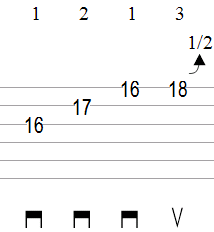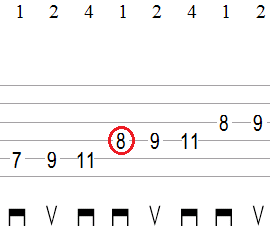How To Create Cool Exotic Guitar Licks Using Expressive Soloing Techniques
By Tom Hess
Fact: you will never become a more creative lead guitarist by repeating the exact same licks or scales (you can already play by heart) over and over. Instead, you must learn how to play with passion, intensity and expression. When you can do this and combine it with exotic guitar licks, your lead guitar playing will sound badass... here's what you need to have to do this:
1. Understanding of exotic scale patterns and chord arpeggios
2. Great command over lead guitar phrasing (knowing HOW to play the notes of any pattern or lick)
Once you have both of these tools in place, you can create awesome lead guitar licks whenever you pick up the guitar.
Fact is, you don't need to know a ton of music theory or have masterful guitar skills – you'll find out what I mean in a few moments.
Before I explain how to play badass licks that will grab people's attention, watch this short video to see how applying the two simple things above leads to killer results:
Now that you've seen how awesome this is, it's time to begin playing some cool licks for yourself. Do the following:
1. Have a look at the tabs below for some exotic lick examples (read the explanations beside them as well)
2. Play each lick many times until it becomes second nature
3. Finally, check out the guitar phrasing section toward the end of this article so you can learn exactly how to make these licks sound awesome
Exotic Guitar Lick #1: This lick is taken from an arpeggio that uses notes of the the Lydian mode (even if you are unfamiliar with modes, you can still easily use this lick). This lick is made exotic through the #4 scale degree in Lydian (circled in the tab) being bent up to the fifth scale degree. This generates a lot of tension, making it sound unfamiliar and exotic to the ear.


Exotic Guitar Lick #1:
Hear It
E Lydian:
Hear It
You can easily apply this exotic lick by playing it above any major (or major add #11) chord. To do so, just move the lick so that it matches the note name of the chord it’s being played over.
Notice: the scale to the right of the lick above is in a different octave, but this does not matter – you can apply the same notes anywhere on the fretboard.
Exotic Guitar Lick #2: This guitar lick comes from the fifth mode of melodic minor. To hear its exotic sound, bend up to the “flat 6” from the fifth below (as shown in the tab to the left).


Exotic Guitar Lick #2:
Hear It
Melodic Minor Mode 5
Hear It
Watch the video above again to hear exactly how to make these exotic guitar licks sound creative and unique.
Key Point: there are many other exotic scales you can use (to learn more about these scales, take the best rock guitar lessons with a great teacher), BUT these licks by themselves are more than enough to get you going when it comes to playing lots of cool lead guitar ideas…specifically after you use them in conjunction with the following phrasing techniques:
How You Can Use Guitar Phrasing To Make These (And Any) Guitar Licks Sound Awesome
Here are various creative guitar phrasing techniques that will cause your licks to sound exotic AND awesome:
1. Creating Intensity Using Slides: You can do much more than just slide from one note to the next. There exist countless ideas you can come up with in your guitar licks by playing slides in uncommon ways. Discover how this is done by reading this instructional article on how to play great guitar licks.
2. Using Bends That Start On Pitches Outside Of The Scale: Instead of beginning every one of your bends on a pitch of the scale (and leading it to the next scale degree above), begin your bend on a non-scale note in between these notes. This produces a highly exotic sound.
Use these two approaches to do this for yourself:
*Using the first exotic lick above, bend upwards from the seventeenth fret on the first E string to get to the eighteenth fret above it. Hear It
*With this same lick, try fretting the seventeenth fret, but pre-bending the string to match the note of the eighteenth fret (bend the string before you actually pick it). Then, attack the string and release the bend down until it almost equals the pitch of the seventeenth fret. Just before the string matches the pitch of the seventeenth fret, immediately play the sixteenth fret. Hear It
Hint: When you slowly release the bend, it generates more tension (this sounds totally badass – check out the video above again to see exactly how I do this). Also, this guitar phrasing style is very reminiscent of the sound of a singer's voice. Check out this creative lead guitar soloing video to learn how you can use this approach.
Important: This particular style of guitar phrasing is a perfect example of utilizing “controlled dissonance” – a creative guitar phrasing idea I show to every one of my students who take the best rock guitar lessons with me. By understanding how to generate tension in your lead guitar soloing (in an intentional manner such as this), you can play highly emotional licks anytime you want. This will set you apart from the overwhelming majority of guitarists who simply play a note and hope for the best (rather than knowing how it will sound ahead of time).
3. Using Guitar Phrases That Have A “Singing” Quality: Almost any great guitar solo you've ever heard probably contains a fundamental melody with creative “ornaments” used to emphasize it. You can do this easily by using a similar approach to how singers create great melodies: By letting specific pitches ring out longer than others (having them be the main body of the lick or idea) and filling in the space between these notes with faster fills. Check out this video on the topic of writing unique guitar solos that sing to learn more.
4. Using Vibrato In An Innovative Manner: Using awesome vibrato technique is the cornerstone to playing incredible lead guitar licks and solos. Apply these creative phrasing methods together with the guitar licks in the tablature at the start of this article (or any other licks you may create):
*Don't stick to only one approach as far as vibrato style goes - Utilize various styles within the same lick. For example, use any combination of thin vibrato (less than a half step), heavy (one half step) or very heavy (one whole step) to accent various important notes.
*Apply vibrato right after you play a note, but sometimes experiment with delaying it for a while by allowing the note ring for a moment (before applying it). When you do this, you build anticipation in the listener. Then, once you finally apply the vibrato, it creates a satisfying sense of release that makes the lick sound that much cooler and intense. Learn more details about using vibrato in this manner by checking out this article on playing awesome guitar solos.
5. Integrating Guitar Phrasing Techniques: If you want to become a truly creative lead guitar player, you have to understand how to combine many phrasing approaches together within every lick you play. Here are several steps to follow that will help you accomplish this:
Step One – Choose any of the licks mentioned in this article (or make your own).
Step Two – Use any of the four phrasing techniques above to play through this lick 12-15 times (creating many variations in the process). Challenge yourself to play each variation as expressively as possible.
Step Three – Combine the guitar phrasing method used from step 2 together with any other method in this article. Then repeat step 2. For ideas on how to combine different phrasing approaches, watch the video above once again.
Now that you know how to use exotic licks and creative guitar phrasing together, you are well on your way to playing KILLER licks and becoming a great lead guitarist. However, understand that there is so much more to learn before you can become a truly great lead guitarist. Find out how to become a killer lead guitarist by signing up for the best rock guitar lessons.
About The Author:
Tom Hess is a professional recording artist, composer, and expert guitar instructor. He teaches and trains guitarists how to become great musicians in his online rock guitar lessons. Visit tomhess.net to receive additional free guitar playing resources and to read more guitar articles.
Post new comment
Please Register or Login to post new comment.